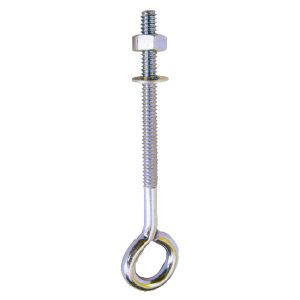Shoulder Eye Bolts
Here’s a detailed overview of shoulder eye bolts in terms of properties, standards,
materials, and specifications.
1. Properties of Shoulder Eye Bolts
- Strength and Stability: Shoulder eye bolts are specifically designed
for applications requiring lateral or angular loads. The shoulder provides additional
reinforcement, making them stronger and more stable than plain eye bolts.
- Versatility: Due to their design, shoulder eye bolts are used in
various lifting, pulling, and anchoring applications. They are suitable for both
vertical and angled lifting, unlike plain eye bolts, which are limited to straight,
vertical lifts.
- Load Bearing: The shoulder of the eye bolt helps distribute the load
evenly and reduces stress on the shank, enhancing its load-bearing capacity and
resistance to bending.
- Safety: Shoulder eye bolts are safer to use in lifting applications
because they are designed to withstand forces from multiple directions when properly
installed.
2. Standards for Shoulder Eye Bolts
Shoulder eye bolts are manufactured according to specific international and regional
standards to ensure safety and reliability in lifting applications. Common standards
include:
- ASME B18.15 (American Society of Mechanical Engineers): This standard
covers the dimensions and load ratings for forged eye bolts, including shoulder types.
- ASTM A489 (American Society for Testing and Materials): This
specification applies to carbon steel, alloy steel, and other types of eye bolts
intended for general lifting purposes.
- DIN 580 (Deutsches Institut für Normung): This German standard
specifies the design and strength for shoulder eye bolts, primarily used in Europe. They
are made according to strict guidelines for safe lifting and rigging applications.
- ISO 3266 (International Organization for Standardization): Specifies
the safety factors, load-bearing capabilities, and material requirements for shoulder
eye bolts used worldwide.
These standards ensure that shoulder eye bolts are manufactured to precise dimensions, load
ratings, and safety requirements. Always check the eye bolt for compliance with relevant
standards, especially for lifting applications.
3. Materials Used in Shoulder Eye Bolts
Shoulder eye bolts are typically made from high-strength materials to handle heavy loads and
resist wear and tear. Common materials include:
- Carbon Steel: Often used in standard shoulder eye bolts for general
lifting applications. Carbon steel provides excellent strength and durability and is
cost-effective.
- Alloy Steel: Known for its higher strength, alloy steel is used in
applications requiring a higher load capacity. It also provides greater resistance to
wear and impact, making it suitable for heavy-duty and industrial uses.
- Stainless Steel: Chosen for its corrosion resistance, stainless steel
shoulder eye bolts are ideal for outdoor or marine environments. They resist rust and
can withstand harsh weather, chemicals, and saline conditions.
- Galvanized Steel: Carbon steel that has been hot-dip galvanized to
improve corrosion resistance. Galvanized shoulder eye bolts are used in outdoor or moist
environments where exposure to the elements is a concern.
Materials for shoulder eye bolts are selected based on the environment, load requirements,
and safety needs of the application.
4. Specifications of Shoulder Eye Bolts
- Size Range: Shoulder eye bolts come in a variety of sizes to
accommodate different applications. Sizes typically range from small diameters (¼ inch
or M6) to larger diameters (up to 1 inch or M24).
- Load Capacity: Load capacities vary widely depending on the bolt size,
material, and intended use. Shoulder eye bolts are usually rated for their working load
limit (WLL), indicating the maximum safe load when used vertically. WLL decreases as the
angle of lift increases.
- Thread Type and Length: Most shoulder eye bolts have standard coarse or
fine threads. The threaded portion's length can vary based on the application, with
longer threads providing better hold in thick materials.
- Finish: Common finishes for shoulder eye bolts include:
- Plain or Self-Colored: Standard finish without additional
treatment, suitable for indoor use.
- Zinc-Plated: Provides basic corrosion resistance.
- Hot-Dip Galvanized: For enhanced rust and corrosion resistance,
especially in outdoor environments.
- Stainless Steel Finish: Provides maximum corrosion resistance,
especially for marine or chemical environments.
- Angular Load Rating: Shoulder eye bolts have specific ratings for
angular loads. For example:
- 0° (Vertical): Full rated load.
- 45°: 30% to 50% of the vertical load capacity, depending on the
material and manufacturer.
- 90°: Roughly 25% of the vertical load capacity.
It’s important to check load rating specifications provided by the manufacturer before use,
especially for critical lifting applications.
Applications of Shoulder Eye Bolts
- Lifting and Hoisting: Shoulder eye bolts are often used to lift
equipment, machinery, or construction materials when rigged with chains, slings, or
ropes.
- Construction and Industrial Use: Due to their durability, they’re
commonly found in construction, manufacturing, and warehousing for tasks that require
lifting and securing loads.
- Marine and Outdoor Applications: When made from corrosion-resistant
materials, shoulder eye bolts are used in marine applications and other outdoor settings
where exposure to moisture and salt is common.
- Machinery and Equipment Attachment: Frequently installed in equipment
or machinery to provide a secure lifting point for repairs or relocation.
Safety Considerations
- Inspection Before Use: Inspect eye bolts for wear, corrosion, or
damage, especially in the eye or shoulder area, before lifting.
- Proper Installation: Ensure the eye bolt shoulder is fully seated and
flush with the load surface, which provides maximum strength. An eye bolt not fully
seated may bend or break under load.
- Load Angle Awareness: Always use shoulder eye bolts within their
specified angular load ratings to avoid unexpected failures.
- Avoid Side Loading: Unless rated for side loading, shoulder eye bolts
should not be loaded from the side, as it can lead to deformation or failure.
Shoulder eye bolts are a reliable choice for a range of lifting and rigging applications. By
following the specifications, standards, and safety guidelines, you can ensure optimal
performance and longevity in their use.
